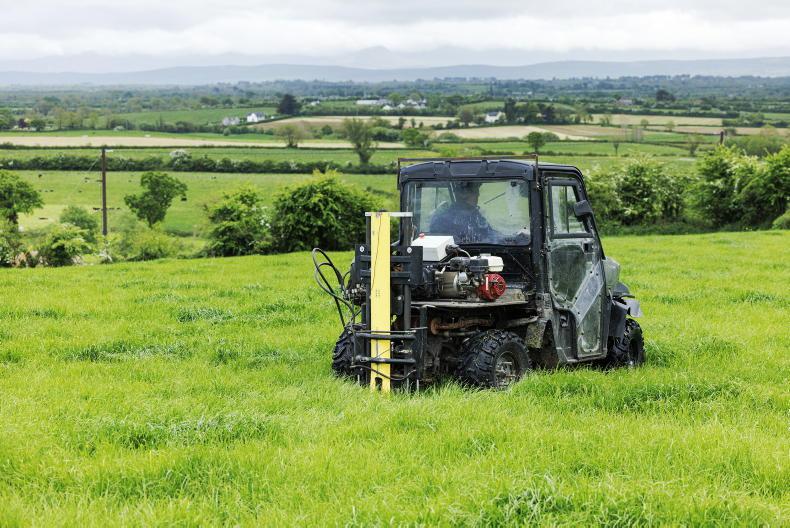Earlier this year, soil sampling was carried out across the Footprint Farms. Some of the results were surprising but, overall, results were positive.
Soil sampling is an important practice to carry out on the farm. It allows farmers to pinpoint where nutrients need to be applied, which avoids wastage and pollution of watercourses as it means that excessive nutrients are not applied to a field where they are not needed.
Soil samples across the eight Footprint Farms were taken to a depth of 10cm, with just shy of 200 samples taken. These farms, which are a mix of dairy, beef, and tillage enterprises, were all sampled in 2021 and it is recommended soil sampling is carried out every two to five years to monitor changes in soil fertility, which can then be managed accordingly.
All samples taken were tested for soil pH, nitrogen (N), phosphorus (P), potassium (K), magnesium (Mg), calcium (Ca), manganese (Mn), zinc (Zn) and boron (B).
At a glance
Overall, results were positive. On average, P indices were at Index 4, while K indices have dropped back to Index 2.
In terms of pH, there were substantial increases in pH across all samples, which is a great result, as correct pH will increase the availability of nutrients in the soil.
The average soil pH this year was 6.6. Some 68% of samples had a pH of 6.3 while, in 2021, 45% of samples were at 6.3 and above. Only 19% of this year’s samples were below a pH of 6, while 33% were below 6 in 2021.
P Indices
There were very positive results to report in terms of the P indices across the farms this year.
Sixty per cent of soils were at Index 3 and 4, which is great to see. While this represents a slight drop from the 2021 figure, which saw 66% of samples at Index 3 and 4, this is still a really good result considering high fertiliser prices recently.
To break down the results more, 35% of samples were at Index 4, 25% at Index 3, 22% at Index 2 and 18% were at Index 1. However, in comparison to the 2021 results, there are more samples falling back into Index 1 this year, which is something that will have to be monitored.
K indices
Results show that soil samples are at Index 2 for K across the farms. While, ideally, there would be more soils in Index 3, this year’s results have seen 20% of soils move into Index 4 in comparison to 2021, when the average was Index 3.
Twenty per cent of soils are now in Index 4, while 25% are in Index 3. Thirty-nine per cent are in Index 2, while 16% are now in Index 1.
In 2021, Thirty-two per cent of total samples were at Index 3, while 37% were at Index 2 and 18% were at Index 1.
Why have indices dropped?
There are a few reasons as to why indices have dropped across certain areas.
In terms of lower P levels, some of these results were in areas with a high soil pH.
In some cases, lower P and K levels can be low on soils with a low pH, which can decrease the availability of nutrients. However, in the cases of some of the Footprint Farms, these lower Ps and Ks were observed on soils with a high pH.
Therefore, these can be addressed by changing fertiliser plans to put more emphasis on K application.
A lot of K deficiencies are on silage ground, so it is recommended that slurry is targeted here and enough K is applied to replace the level taken off in the silage crop.
While fertiliser prices remain high and slurry should be the first port of call, in some cases a top-up of straight potash fertiliser may be needed.
On tillage farms, chopping straw is another excellent way of returning K to the soil.
Where P and K levels are at an optimum, farmers can turn their attention to trace element levels.
These soil samples were also tested for Mg, Ca, Mn, Zn and B. Similar to 2021, this year’s results show high levels of copper and very high levels of zinc, while boron levels were very low.
These results tend to be dependent on the geographical location of the farm, as factors such as bedrock type affect this. However, trace elements can present challenges for farmers in terms of deficiencies in livestock.
While copper levels are high across the farms, this does not necessarily mean that the element is high in forage. Therefore, leaf analysis can be carried out in some cases to test trace elements in the grass.
While boron levels were low across the farms, it is only needed in small amounts as it becomes toxic at high levels.






 This is a subscriber-only article
This is a subscriber-only article









SHARING OPTIONS: